- Home
- Max Brooks
The Zombie Survival Guide: Complete Protection From the Living Dead Page 6
The Zombie Survival Guide: Complete Protection From the Living Dead Read online
Page 6
9. ACCESSORIES
Silencers, if attainable, can be a vital attachment to your firearm. Their ability to muffle noise obviates the need for a bow, sling, or other non-ballistic weapon (essential if on the move).
A telescopic sight can increase aim immeasurably, especially for long-range sniper attacks. Laser sights, on the surface, may be your best bet. After all, how hard is it to place a red dot on a ghoul’s forehead? The disadvantage is limited battery life. The same goes for night-vision scopes. Although they allow for accurate, long-range hits on zombies after dark, they become nothing more than useless black tubes when the power runs out. Conventional glass and metal sights are the preferable accessory. They may not be fancy, and they may lack the cachet of electronics, but these basic instruments will never let you down.
RANGE versus ACCURACY
Studies have shown that, given the trauma of battle, the closer a human is to a zombie, the wilder his shooting will be. When practicing with your firearm(s), establish a maximum range for repeated accuracy. Practice against moving targets in ideal (stress-free) conditions. Once that range is fixed, divide it by half. This will be your effective kill zone during an actual attack. Make sure the undead do not move closer than this zone, as your accuracy will erode. If engaging a group, make sure to hit those that enter the zone first before dispatching the others. Do not discount this advice no matter what your previous experience has been. Street-hardened police officers, decorated combat veterans, even “cold-blooded” murderers have ended up as well-chewed meat because they believed in their “nerves” and not their training.
EXPLOSIVES
Question: What could be better than hurling a hand grenade at a mass of approaching zombies? Answer: almost anything. Anti-personnel explosives kill mainly by shrapnel, metal shards tearing through vital organs. As this will not affect zombies, and the chance of shrapnel penetrating the skull is slim, grenades, bombs, and other explosive tools are inefficient weapons.
These devices should not be completely discounted, though. For blasting through doors, creating instant barricades, or even scattering zombie mobs, nothing works better than a jar of gunpowder.
FIRE
The living dead have no fear of fire. Waving an open flame in a ghoul’s face will do nothing to slow or impede its advance. Zombies who have caught fire will neither notice nor react to the engulfing flames in any way. Too many humans have met with tragedy for failing to understand that fire is no deterrent to zombies!
As a weapon, however, fire is still humanity’s greatest ally. Complete incineration is the best way to destroy a zombie once and for all. Burning eliminates not only the body but all traces of Solanum. However, don’t think a flamethrower and several Molotov cocktails are the solution to all your problems. In actual combat, fire can be as deadly a threat as it is a protector.
Flesh—human, undead, or otherwise—takes a long time to burn. In the minutes or hours before a blazing zombie succumbs, it will become a walking—or to be perfectly accurate, a shambling—torch. Several cases have been recorded in which burning ghouls have done more damage, even caused more deaths, than they would have with only their fingernails and teeth.
Fire itself has no loyalty. Consider the flammable nature of your surroundings, the chance of smoke inhalation, the possibility that a blaze will act as a beacon for other zombies. All these factors must be considered before such a powerful and unpredictable weapon is unleashed.
For this reason, fire is mainly considered an attack or flight weapon, and rarely used for static defense.
1. MOLOTOV COCKTAILS
This term applies to any jar of flammable liquid with a primitive fuse. It is a cheap, effective way to kill multiple zombies at once. If the situation permits—e.g., fleeing an advancing horde, clearing a fireproof structure, or destroying a flammable structure with multiple zombies trapped in it—by all means, bombard the ghouls in question until nothing is left but ash.
2. DOUSING
The act of dousing consists of simply filling a bucket with flammable liquid (gasoline, kerosene, etc.), throwing it at a zombie or zombies, lighting a match, and running. If there is room for escape and no danger of residual fire damage, the only drawback to this method is the close proximity required to fully drench the enemy.
3. THE BLOWTORCH
The common torch, which consists of a propane tank attached to a nozzle, has neither the heating power nor the fuel supply to burn through a zombie skull. But it can be a convenient firestarter if the undead in question have already been soaked in a flammable liquid.
4. THE FLAMETHROWER
This device, perhaps more than any other, strikes people as the ultimate zombie eliminator. A jet of flame, two hundred feet long, composed of jellied gasoline, can turn an undead crowd into a wailing funeral pyre. So why not acquire one? Why not forsake all other weapons for this man-made fire-breathing dragon? The answers are as realistic as they are numerous. The flamethrower was developed purely as a military weapon and is no longer in service with the U.S. Army and Marine Corps. It would be difficult to find any model, let alone one that works properly. Acquiring the fuel is even more difficult than the thrower. But assuming you can find both, you must consider its practical use. Why carry seventy pounds of equipment on your back when only a handful of ghouls are loose? A flamethrower’s weight makes it a liability if you are on the move. Unless you are in a fixed position or have access to motorized transport, sheer exhaustion will become as dangerous a threat as the walking dead. Common sense would suggest that a flamethrower’s place on the battlefield is against overwhelming numbers, swarms of undead numbering in the hundreds if not thousands. If such a horde were, heaven forbid, to exist, chances are they would be facing a much larger, well-equipped government force rather than one private citizen and his trusty (and let’s not forget illegal) flamethrower.
OTHER WEAPONS
Imagination and improvisation are two invaluable assets during clashes with the living dead. By all means, feel free to regard all the materials around you as a cache of potential weapons. But always keep in mind a zombie’s physiology, and what your homemade device is likely to accomplish.
1. ACID
Apart from fire, sulfuric acid is the best way to completely destroy a zombie. Implementing it is another matter. If somehow you have the means to acquire or produce large amounts of sulfuric acid, treat it with the same respect you would an incendiary weapon. Not only is this substance as much a danger to yourself as it is to the undead, the time it takes to dissolve zombie flesh and bone is considerable. Acid should be used as a post-encounter disposal tool rather than a combat weapon.
2. POISON
As there are hundreds of thousands of lethal compounds in this world, it is impossible to discuss them all. Instead, we will review some basic rules that govern the physical and physiological makeup of the undead. Zombies are immune to all types of tranquilizers and irritants such as Mace and tear gas. Any compound designed to halt bodily functions would be equally impotent, as the undead no longer require these functions. Zombies do not suffer from heart attacks, nerve paralysis, suffocation, or any other fatal effects caused by poison.
3. BIOLOGICAL WARFARE
Wouldn’t it be poetic to destroy beings infected by a virus with another virus? Unfortunately, this is not an option. Viruses attack only living cells. They have no effect on the dead. The same is true for all types of bacteria. Several laboratory attempts have been made to culture and spread necrotizing fasciitis (a flesh-eating bacterial disease) among captured zombies. None have proved successful. Experiments are now under way to grow a new strand of bacterium that feeds only on dead flesh. Most experts are skeptical of its success. Tests are ongoing to determine which of the many microorganisms normally involved in decomposition continue to consume flesh in spite of its infected nature. If these microbes can be isolated, reproduced, and delivered in a manner not harmful to its user, they could be humanity’s first weapon of mass destruction in th
e battle against the living dead.
4. ZOOLOGICAL WARFARE
Hundreds of creatures, great and small, feed on carrion. Employing some of these animals to devour the dead before they devour the living might seem the ideal solution. Unfortunately, all species, from hyenas to fire ants, instinctively avoid zombies. The highly toxic nature of Solanum appears to be encoded in the survival patterns of the animal kingdom. This mysterious warning signal that Solanum emits, be it an odor or some kind of “vibe” long forgotten by humans, is impossible to mask by any known substance. (See “1911 A.D., Vitre, Louisiana.”)
5. ELECTROCUTION
As the zombie’s muscular system is basically that of a human, electricity does have the ability to temporarily stun or paralyze its body. Lethal results have been seen only in extreme cases such as power lines used to completely char a zombie’s brain. This is not a “wonder weapon”—the current that runs through power lines is enough to burn almost any organic matter, living or undead, to a crisp. It requires twice the voltage to stun a zombie that it does to stun a human, so common taser guns are ineffective. Electricity has been used to create a temporary barrier with water-filled, electrified ditches to keep ghouls paralyzed long enough for a secondary fatal method to be employed. Several such incidents have been recorded over the years.
6. RADIATION
Experiments are now being conducted to test the effects of microwaves and other electromagnetic signals on the brains of the undead, on the theory that such a device could generate massive, instant, lethal tumors in a zombie’s gray matter. Research is still in its early stages, and results have so far been inconclusive. The only known instance when zombies came into contact with gamma radiation occurred during the notorious Khotan Incident. (See “1987 A.D., Khotan, China.”) In this event, the ghouls were not only unaffected by rads that would have killed humans, but they threatened to spread their contamination throughout the province. For the first time, the world glimpsed a new and even deadlier threat: the radioactive zombie. As much as this sounds like the product of bad 1950s science fiction, it is, or was, a very real and historically significant fact. According to records, the radioactive ghouls possessed no enhanced abilities or magical powers. The threat they posed lay in their ability to spread deadly radiation to everything and everyone they touched. Even people who drank from a water supply the ghouls had touched died soon afterward from radiation sickness. Fortunately, the outbreak was crushed by the overwhelming power of the Chinese army. Not only did this solution put an end to this new danger—it prevented the disaster of the Khotan reactor going critical.
7. GENETIC WARFARE
Some recent proposals recommend a variety of genetic weapons in the war against the undead. The first step would be to map the genetic sequence of Solanum. Next, an agent would be developed to rewrite that sequence, ordering the virus to suspend its attack on human tissue, turn on itself, or simply self-destruct. Instead of retraining the zombie, we would retrain the virus that controls the zombie. If successful, any of these agents would be a revolutionary breakthrough in combating the undead. Through genetic engineering we could find an actual cure. Celebration of this breakthrough, however, will have to wait. The science of genetic therapy is still in its infancy. Even with media attention and massive financial resources, both of which are nonexistent, an agent to combat the virus will have to remain a theory.
8. NANOTHERAPY
Nanotechnology, the study of microscopic machinery, is only in its adolescence. At present, experimental computer chips are being made that are no bigger than a molecule! One day robots that small will be able to perform tasks within the human body. These nanobots, or whatever the accepted term will be, will one day destroy cancer cells, repair damaged tissue, even attack and destroy hostile viruses. Theoretically, there is no reason why they could not be injected by the billions into a recently infected human to identify the Solanum virus and eradicate it from the system. When will this technology be perfected? When will it find its way into the medical profession? When will it be adapted for combating Solanum? Only time will tell.
ARMOR
Speed and agility should be your first defense against the walking dead. Armor will not only decrease both these advantages that you have over zombies, but it will also sap your energy during prolonged conflict. Add the risk of dehydration, and the prospect seems even less attractive. One final, less obvious disadvantage to armor is not physical but psychological: People wearing protective garb tend to feel more confident and therefore take greater risks than those in simple clothing. This artificial bravery has resulted in too many senseless deaths. Simply put, the best protection from a zombie bite is distance. If for some reason you insist on some type of protective gear, the follow-ing summary will provide all the information necessary for prudent decision-making.
1. PLATE MAIL
This could be defined as the classic “suit of armor.” The term itself conjures up images of seemingly invincible knights dressed from head to toe in shining steel. With so much protection, wouldn’t one be able to wander among the undead ranks, taunting them at will with no danger of repercussion? In truth, standard medieval armor is far from invulnerable. The leather or metal joints that hold its many pieces together can be torn apart by an individual’s persistent hands, to say nothing of a mob. Even intact, steel suits are heavy, cumbersome, suffocating, dehydrating, and extremely noisy. If possible, study and wear a real suit of armor and practice fighting in it against even one (mock) attacker. You will find the experience uncomfortable at best, excruciating at worst. Now imagine five, ten, fifty attackers, all converging on your position, grabbing at the plates, pulling them in all directions. Without the speed to outrun them or the agility to avoid them, even the necessary vision to find and strike them, you will almost certainly end up as little more than canned food.
2. CHAIN MAIL
If worn from head to toe, this simpler form of armor actually does provide some protection from zombie bites. Teeth will be unable to penetrate its links, thereby saving you from infection. Its flexibility allows for greater movement and speed; its lack of a faceplate allows for greater visibility. Its very nature (unlike solid plates) allows the skin to breathe and thereby cuts down on dehydration and overheating. Drawbacks, however, are still plentiful. Unless you have been training with this armor for years, your combat effectiveness is bound to be impaired. Its weight can still increase exhaustion. Its general discomfort can lead to unwanted distraction, something that must be avoided in battle. Although chain mail may keep you safe from infection, the pressure of a zombie bite may still be enough to crack bones, tear muscles, or rip flesh within the armor. As with plate mail, the clanking of so many chain links will signal to any nearby zombies that prey has arrived. Unless you want your presence announced, discount this idea entirely. On a practical note, if you choose chain mail, make sure it is battle-quality! Much of the medieval or ancient armor produced today is for decoration or stage performance. For this reason, less expensive alloys are used in their production. When purchasing your chain mail, always ensure, through inspection and careful testing, that it can withstand a zombie’s bite.
3. THE SHARK SUIT
Although designed for protection against shark bites, this mesh bodysuit can stand up to the toughest undead jaws. Made of either high-tensile steel or titanium, it provides twice the protection of chain mail with half the weight. Noise, however, is still a factor, as well as physical discomfort and decreased speed and agility. Shark suits might come in handy if hunting the dead underwater. (See “Underwater Battles.”)
4. HELMETS
This type of armor would be invaluable to ghouls, if only they knew enough to wear them. To humans, they serve no purpose other than obstructing vision. Unless your battle is taking place in a “hard hat area,” avoid this cumbersome waste of space.
5. BULLETPROOF VESTS
Because almost all combat-related zombie bites occur on the limbs, this and other torso armor are a tota
l waste of time. One might consider a bulletproof vest only in a chaotic situation in which there is a chance of being shot by your own people. Even in this situation, the misguided sniper would probably be going for a head shot.
6. KEVLAR COVERS
In recent years, law enforcement have begun to equip officers with this light, ultra-strong material. While thicker, harder plates are used in vests to stop bullets, a thinner, more flexible version is employed to stop blades and the occasional guard dog. This new version, if covering the lower legs and forearms, can help to reduce the risk of zombie bites in close-quarter situations. If you do acquire Kevlar covers, make sure to wear them only during battle, and do not draw any false bravery from them! Many humans in the past have believed that Kevlar or similar kinds of body armor gave them carte blanche to take unnecessary risks. No armor in the world can protect a human from that kind of stupidity. As stated before, your goal is to survive, only survive, and never be a hero. Bravado in combat is the surest way to endanger yourself and those around you!

 World War Z: An Oral History of the Zombie War
World War Z: An Oral History of the Zombie War Minecraft: The Island
Minecraft: The Island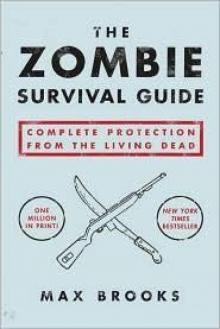 The Zombie Survival Guide: Complete Protection From the Living Dead
The Zombie Survival Guide: Complete Protection From the Living Dead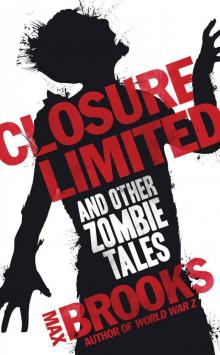 Closure, Limited and Other Zombie Stories
Closure, Limited and Other Zombie Stories Devolution: A Firsthand Account of the Rainier Sasquatch Massacre
Devolution: A Firsthand Account of the Rainier Sasquatch Massacre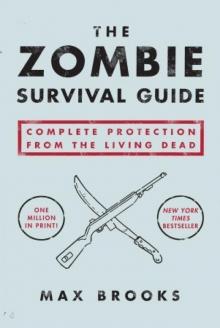 The Zombie Survival Guide
The Zombie Survival Guide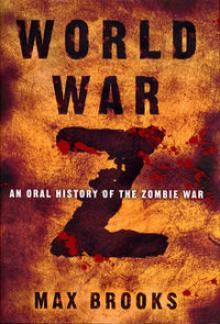 World War Z
World War Z Closure, Limited
Closure, Limited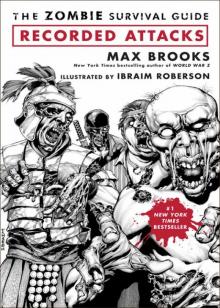 The Zombie Survival Guide: Recorded Attacks
The Zombie Survival Guide: Recorded Attacks World War Z_An Oral History of the Zombie War
World War Z_An Oral History of the Zombie War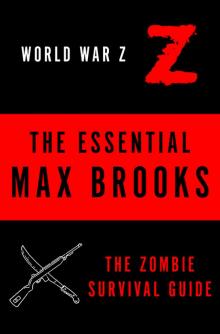 The Essential Max Brooks: The Zombie Survival Guide and World War Z
The Essential Max Brooks: The Zombie Survival Guide and World War Z